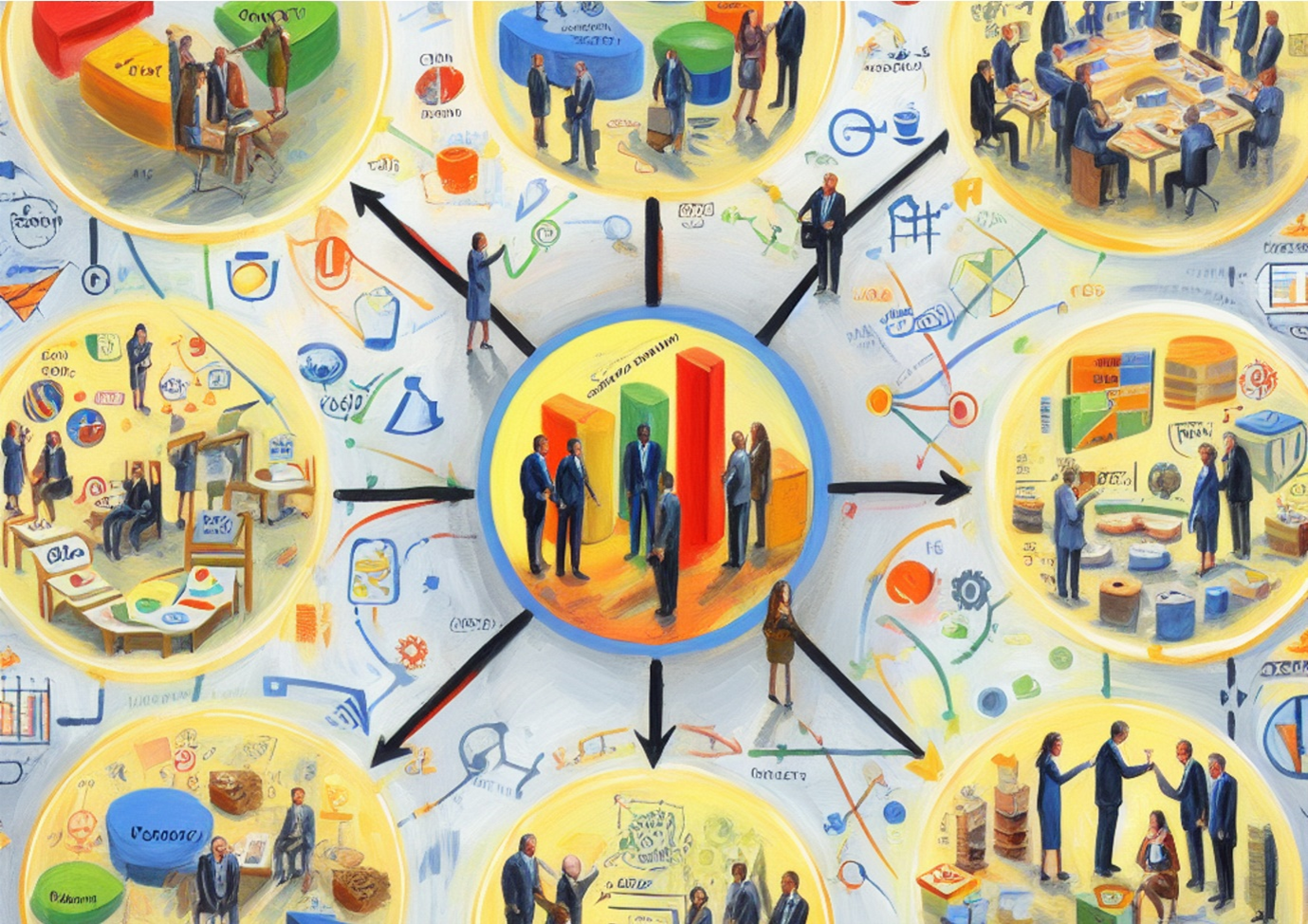Enhancing Stakeholder Value in SMEs and MSMEs: A Comprehensive Guide
Article Date | 9 January, 2024
By Kirill Koniayev, Lecturer in Business, LSST Birmingham
Understanding Stakeholders in the Modern Business Context
In today’s business landscape, the concept of stakeholder value is paramount, especially for Small and Medium-sized Enterprises (SMEs) and Micro, Small, and Medium-sized Enterprises (MSMEs) (Rutterford, 1998; Svendsen, 1998). Freeman (1984, p.46), defined stakeholders as “any group or individual who can affect or is affected by the achievement of the organization’s objectives”. This definition revolutionised the way businesses view their ecosystem, expanding the focus beyond just shareholders to include customers, employees, suppliers, communities, and even competitors (Rutterford, 1998; Svendsen, 1998).
Adding to this, the concept of Creating Shared Value (CSV) emphasises the importance of generating economic value in a way that also produces value for society (Porter and Kramer, 2018; Porter and Kramer, 2011). This approach redefines the boundaries of capitalism, suggesting that the success of a company and the well-being of the community around it are mutually dependent (Koirala, 2018; Porter and Kramer, 2011).
Incorporating these foundational perspectives, this blog delves into how SMEs and MSMEs can navigate and enhance stakeholder relationships, ensuring synergy between business success and societal progress (Koirala, 2018; Porter and Kramer, 2011).
Delving Deeper into Stakeholder Value for SMEs and MSMEs
For smaller businesses, stakeholder value often centres around more intimate relationships and direct engagement (The Federation of Small Businesses, n.d.). Unlike bigger organisations, SMEs and MSMEs have the advantage of closely interacting with their stakeholders, leading to more significant and meaningful impacts (Koirala, 2018).
Customers: The Heartbeat of Your Business
In SMEs and MSMEs, customers are more than just revenue sources; they are integral to the business’s fabric (Albaz et al., 2020). Tailoring services to meet local needs, building trust through consistent transparency, and maintaining an open dialogue are key strategies (Rane, Achari and Choudhary, 2023). Regular feedback mechanisms and adapting swiftly to customer preferences can elevate the value offered (Swift, 2001).
Employees: The Pillars of Strength
In smaller enterprises, each employee’s contribution is magnified. Investing in their professional development and nurturing a supportive workplace culture can exponentially boost productivity and loyalty (Nagori, 2022). SMEs and MSMEs stand to gain immensely from cultivating a team ethos where every member’s input is valued and respected (Gherghina et al., 2020).
Suppliers: Collaborative Growth Partners
For many businesses, suppliers are the backbone, providing essential goods and services. Establishing robust, ethical, and mutually beneficial relationships with suppliers ensures a stable and reliable supply chain (Oxford College of Procurement and Supply, 2016). Collaborative strategies such as joint resource planning or shared innovations can yield mutual benefits (Zahoor and Al-Tabbaa, 2020).
Communities: Nurturing Local Bonds
Community engagement is paramount for SMEs and MSMEs (Bhinekawati, 2018). Actions ranging from sponsoring local events to implementing eco-friendly business practices can leave a lasting positive imprint (Moursellas et al., 2022). This not only bolsters the company’s standing but also contributes to the socio-economic health of the community (Miklian and Hoelscher, 2021).
Investors: Aligning Visions and Realities
Investors in SMEs and MSMEs often seek a blend of financial returns and the realisation of personal business aspirations (OECD, 2017). Regular, transparent communication about business trajectories, challenges, and strategic plans helps in synchronising expectations and fortifying investor relations (Butler, 2023; Hoffmann, 2018).
Industry-Specific Challenges: Turning Obstacles into Opportunities
Each industry presents unique challenges (Bain and Company, n.d.). Tech SMEs, for example, may face hurdles with evolving technologies (Pylaeva et al., 2022), while retail MSMEs might confront intense online competition (Susanti, Mulyanti and Wati, 2023). Identifying these industry-specific challenges and transforming them into opportunities is crucial for stakeholder value enhancement (Fobbe and Hilletofth, 2021).
Embracing Innovation and Adaptability
In today’s fast-paced business world, SMEs and MSMEs must be innovative and adaptable (Srisathan, Ketkaew and Naruetharadhol, 2023). Embracing new technologies or adapting business models in response to market shifts is not just advantageous but necessary for survival and growth (Adam and Alarifi, 2021; Geissdoerfer, Vladimirova and Evans, 2018).
The Road Ahead: Fostering a Stakeholder-Centric Ethos
The future of successful business practice lies in recognising and valuing each stakeholder’s role (Fobbe and Hilletofth, 2021). For SMEs and MSMEs, this means cultivating a culture that acknowledges the importance of every stakeholder interaction and strives to add value consistently (Koirala, 2018). By doing so, these enterprises not only secure their foothold but also pave the path towards long-term prosperity and growth.
Conclusion: A Vision for Sustainable Business
Ultimately, the goal for SMEs and MSMEs is to evolve into organisations where stakeholder value is ingrained in every aspect of the business. This approach not only ensures resilience in the face of market fluctuations but also positions these enterprises as pillars of sustainable and ethical business practices in the 21st century.
References
Adam, N.A. and Alarifi, G. (2021). Innovation practices for survival of small and medium enterprises (SMEs) in the COVID-19 times: the role of external support. Journal of Innovation and Entrepreneurship, [online] 10(1). doi: https://doi.org/10.1186/s13731-021-00156-6.
Albaz, A., Rida, T., Dondi, M. and Schubert, J. (2020). Unlocking growth in small and medium enterprises | McKinsey. [online] www.mckinsey.com. Available at: https://www.mckinsey.com/industries/public-sector/our-insights/unlocking-growth-in-small-and-medium-size-enterprises.
Bain & Company (n.d.). Industries. [online] Bain. Available at: https://www.bain.com/industry-expertise/ [Accessed 6 Jan. 2024].
Bhinekawati, R. (2018). A Model of a Large Company’s CSR and Transformational Community Engagement Strategy for SME Development. ASEAN Journal of Community Engagement, 2(2), p.200. doi: https://doi.org/10.7454/ajce.v2i2.130.
Butler, R. (2023). Council Post: Three Principles Of Transparent Communication. [online] Forbes. Available at: https://www.forbes.com/sites/forbesbusinesscouncil/2023/06/29/three-principles-of-transparent-communication/.
Fobbe, L. and Hilletofth, P. (2021). The role of stakeholder interaction in sustainable business models. A systematic literature review. Journal of Cleaner Production, [online] 327(129510), p.129510. doi: https://doi.org/10.1016/j.jclepro.2021.129510.
Freeman, R.E. (1984). Strategic Management: A Stakeholder Approach. Cambridge: Cambridge University Press, p.46.
Geissdoerfer, M., Vladimirova, D. and Evans, S. (2018). Sustainable business model innovation: A review. Journal of Cleaner Production, [online] 198(1), pp.401–416. doi: https://doi.org/10.1016/j.jclepro.2018.06.240.
Gherghina, S.C., Botezatu, M.A., Hosszu, A. and Simionescu, L.N. (2020). Small and Medium-Sized Enterprises (SMEs): The Engine of Economic Growth through Investments and Innovation. Sustainability, [online] 12(1), p.347. doi: https://doi.org/10.3390/su12010347.
Hoffmann, C.P. (2018). Investor Relations Communication. The International Encyclopedia of Strategic Communication, pp.1–11. doi: https://doi.org/10.1002/9781119010722.iesc0094.
Koirala, S. (2018). SMEs: Key Drivers of Green and Inclusive Growth. [online] Available at: https://www.oecd.org/greengrowth/GGSD_2018_SME%20Issue%20Paper_WEB.pdf [Accessed 4 Jan. 2024].
Miklian, J. and Hoelscher, K. (2021). SMEs and exogenous shocks: A conceptual literature review and forward research agenda. International Small Business Journal: Researching Entrepreneurship, 40(2), pp.178–204. doi: https://doi.org/10.1177/02662426211050796.
Moursellas, A., De, D., Wurzer, T., Skouloudis, A., Reiner, G., Chaudhuri, A., Manousidis, T., Malesios, C., Evangelinos, K. and Dey, P.K. (2022). Sustainability Practices and Performance in European Small-and-Medium Enterprises: Insights from Multiple Case Studies. Circular Economy and Sustainability. doi: https://doi.org/10.1007/s43615-022-00224-3.
Nagori, R. (2022). Improving Employee Engagement in Small and Medium Enterprises. In: K. Biginas, S. Sindakis, A. Koumproglou, V. Sarantinos and P. Wyer, eds., Small Business Management and Control of the Uncertain External Environment. [online] Emerald Publishing Limited, pp.151–177. doi: https://doi.org/10.1108/978183909624220211010.
OECD (2017). Small Businesses, Job Creation and Growth: Facts, Obstacles and Best Practices. [online] Available at: https://www.oecd.org/cfe/smes/2090740.pdf [Accessed 6 Jan. 2024].
Oxford College of Procurement and Supply (2016). The Advantages of A Well Managed Supplier Relationship. [online] Oxford College of Procurement and Supply. Available at: https://www.oxfordcollegeofprocurementandsupply.com/the-advantages-of-a-well-managed-supplier-relationship/ [Accessed 5 Jan. 2024].
Porter, M.E. and Kramer, M.R. (2011). Creating Shared Value. [online] Harvard Business Review. Available at: https://hbr.org/2011/01/the-big-idea-creating-shared-value [Accessed 4 Jan. 2024].
Porter, M.E. and Kramer, M.R. (2018). Creating Shared Value. Managing Sustainable Business, [online] pp.323–346. doi: https://doi.org/10.1007/978-94-024-1144-7_16 [Accessed 8 Jan. 2024].
Pylaeva, I.S., Podshivalova, M.V., Alola, A.A., Podshivalov, D.V. and Demin, A.A. (2022). A new approach to identifying high-tech manufacturing SMEs with sustainable technological development: Empirical evidence. Journal of Cleaner Production, 363, p.132322. doi: https://doi.org/10.1016/j.jclepro.2022.132322.
Rane, N., Achari, A. and Choudhary, S.P. (2023). ENHANCING CUSTOMER LOYALTY THROUGH QUALITY OF SERVICE: EFFECTIVE STRATEGIES TO IMPROVE CUSTOMER SATISFACTION, EXPERIENCE, RELATIONSHIP, AND ENGAGEMENT. International Research Journal of Modernization in Engineering Technology and Science, [online] 5(5). doi: https://doi.org/10.56726/irjmets38104.
Rutterford, J. ed., (1998). Financial strategy : adding stakeholder value. Chichester ; New York: Wiley.
Srisathan, W.A., Ketkaew, C. and Naruetharadhol, P. (2023). Assessing the effectiveness of open innovation implementation strategies in the promotion of ambidextrous innovation in Thai small and medium-sized enterprises. Journal of Innovation & Knowledge, [online] 8(4), p.100418. doi: https://doi.org/10.1016/j.jik.2023.100418.
Susanti, E., Mulyanti, R.Y. and Wati, L.N. (2023). MSMEs performance and competitive advantage: Evidence from women’s MSMEs in Indonesia. Cogent Business & Management, 10(2). doi: https://doi.org/10.1080/23311975.2023.2239423.
Svendsen, A. (1998). The Stakeholder Strategy. Berrett-Koehler Publishers.
Swift, R.S. (2001). Accelerating customer relationships : using CRM and relationship technologies. Upper Saddle River, Nj: Prentice Hall Ptr.
The Federation of Small Businesses (n.d.). Small Business, Big Heart: Bringing communities together. [online] www.fsb.org.uk. Available at: https://www.fsb.org.uk/resource-report/small-business-big-heart-communities-report.html [Accessed 4 Jan. 2024].
Zahoor, N. and Al-Tabbaa, O. (2020). Inter-organizational collaboration and SMEs’ innovation: A systematic review and future research directions. Scandinavian Journal of Management, 36(2), p.101109. doi: https://doi.org/10.1016/j.scaman.2020.101109.




